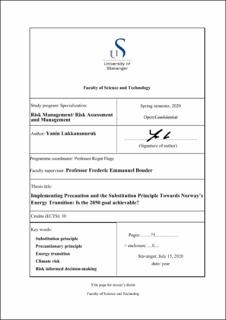| dc.contributor.advisor | Bouder, Frederic E | |
| dc.contributor.author | Lukkananuruk, Yanin | |
| dc.coverage.spatial | Norway | en_US |
| dc.date.accessioned | 2020-10-16T08:39:05Z | |
| dc.date.available | 2020-10-16T08:39:05Z | |
| dc.date.issued | 2020-06-15 | |
| dc.identifier.uri | https://hdl.handle.net/11250/2683253 | |
| dc.description | Master's thesis in Risk management | en_US |
| dc.description.abstract | The Substitution principle has a significant role in the energy transition. This pillar is considered a subset of the precautionary principle, aligned with the concept of sustainability. However, there has been rather limited research about a fundamental concept of the substitution principle in transition policy. Previous research has primarily discussed the substitution principle in the Swedish chemical policy. The case in the Sweden's control policy leads to a suspicion of Norwegian policy and its goal. A question has been raised about whether the 2050 goal to become a low carbon society is achievable. This study aims to examine the role of precautionary and substitution principles towards the Norwegian low carbon policy. The purposes of this study contain as the following: 1) to explore the role of scientific evidence and risk informed decision-making process, 2) to study how these fundamental principles would work in energy transition policy, and 3) to find out the possibility to reach its target.
This paper is derived from the in-depth exploration of interview participants’ cognition, and public official policy documents. The study involved qualitative research with an interview platform and content analysis of policy documents. The in-depth interviews were conducted with semi open-ended questions. A sample was selected from individuals who have an educational background and work experience within the field of energy, risk and safety. The interview responses and data from the official policy documents were collected and thereby used for data analysis.
The findings indicate that the energy transition requires the substitution principle. The government has a critical role in pushing for a faster transition towards their low carbon ambitions. The fundamental principle of substitution is remarkably neglected. While the precautionary principle still has also received minimal attention. A comparison of research results between content analysis of policy documents and detailed interviews emphasizes the importance of scientific evidence and risk informed approach as it clearly plays a vital role to support decision-making. Furthermore, it was found that Norway still has a chance to achieve the long-term goal by 2050 if even more enhanced ambition on policy strategy. However, given the current ambiguity of ambition towards low carbon transition policy, it is unclear as to whether it could actually be accomplished. Even though most interviewees hold some optimistic beliefs, it appears that the pathway to reaching the target is still in doubt. Hence, the precautionary instruments should be implemented intensively and increasingly more ambitious policies, especially in terms of technology development. | en_US |
| dc.language.iso | eng | en_US |
| dc.publisher | University of Stavanger, Norway | en_US |
| dc.relation.ispartofseries | Masteroppgave/UIS-TN-ISØP/2020; | |
| dc.rights | Navngivelse 4.0 Internasjonal | * |
| dc.rights.uri | http://creativecommons.org/licenses/by/4.0/deed.no | * |
| dc.subject | risikostyring | en_US |
| dc.subject | substitution principle | en_US |
| dc.subject | precautionary principle | en_US |
| dc.subject | energy transition | en_US |
| dc.subject | climate risk | en_US |
| dc.subject | risk informed decision-making | en_US |
| dc.title | Implementing Precaution and the Substitution Principle Towards Norway’s Energy Transition: Is the 2050 goal achievable? | en_US |
| dc.type | Master thesis | en_US |

